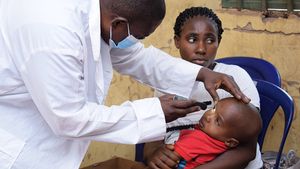There's a potentially troubling fungal skin infection with a case detected in New York City to be aware of as we gather to celebrate Pride Month and the warm summer weather.
According to experts, there's a new sexually transmittable strain of tinea, aka ringworm (often called "jock itch" when in the groin area). While tinea can be treated with standard ringworm treatment, it can take months to clear up, pausing your summer fun.
Ringworm, often characterized by the ring-like rashes it causes on the skin, may be easy to spot, but this new variation doesn’t always appear as rings. This difference in appearance makes this newer strain less noticeable and easy to confuse with other skin issues, such as eczema.
It must be said plainly that ringworm does not involve actual worms; the name comes from how the fungal infection forms a circle of red scaly skin, similar to a worm when it curls and touches end to end.
Until recently, cases of this new tinea strain were more prevalent in Europe, with over a dozen cases reported last year in France. However, a case has been detected in the United States after a man returned from extensive travels and interactions, according to details published this week in the journal JAMA Dermatology.
According to JAMA, a man in his 30s was diagnosed with the new variation of tinea genitalis/pubogenitalisa with a rash on his penis, buttocks, and limbs. Before returning to New York City, the man had multiple stops on his travels to Greece, England, and California. He also shared that he’d had numerous sexual encounters with other men on his travels (none of whom reported similar skin issues), which requires skin-to-skin contact. We promise we are not slut shaming whatsoever here at PRIDE. This is important to know because tinea can be spread by skin-to-skin contact or indirectly by sharing personal items such as brushes, towels, clothes, shoes, or even contact with contaminated surfaces such as floors.
Through genetic testing, experts were able to identify that his fungal infection was, in fact, the new sexually transmitted strain, Trichophyton mentagrophytes type VII (TMVII).
In a research press release, study lead author Dr. Avrom S. Caplan of the NYU Grossman School of Medicine said, "Healthcare providers should be aware that Trichophyton mentagrophytes type VII is the latest in a group of severe skin infections to have now reached the United States."
While the study findings note that TMVII can usually be treated with a standard anti-fungal called terbinafine, the condition may take a while to clear up.
“Since patients are often reluctant to discuss genital problems, physicians need to directly ask about rashes around the groin and buttocks, especially for those who are sexually active, have recently traveled abroad, and report itchy areas elsewhere on the body,” said study senior author John G. Zampella, MD.
Last month, Dr. Caplan explored another new skin condition that may present a more significant challenge for dermatologists — Trichophyton indotineae. T. indotineae, whilecommonly widespread in India, is now being reported globally. First confirmed in the United States last year, the infection causes itchy and contagious rashes similar to TMVII but often resists terbinafine treatment.
When seven of the patients did not respond to the usual anti-fungal treatment, researchers analyzed the genetic code of the fungus. They found several mutations that made it resistant to the typical medicines used. Instead, they had to use another, more potent medical drug called itraconazole. The downside, however, is this medication can interfere with many other medications and carries a greater likelihood of side effects such as nausea, diarrhea, and other side effects that make it hard to use for long periods.
Dr. Caplan adds that he plans to work with leading fungi experts around the United States and internationally over the next few months to expand research efforts and track emerging cases.
The researchers caution that while dermatologists should be vigilant for signs of TMVII and T. indotineae in their patients, rates remain low in the United States.
From Your Site Articles
Related Articles Around the Web


















































































